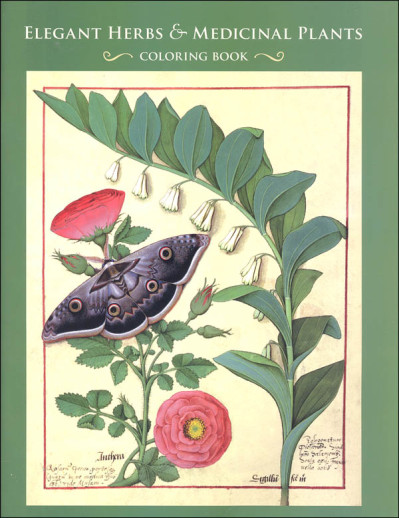We use cookies to make your experience better. To comply with the new e-Privacy directive, we need to ask for your consent to set the cookies. Learn more.
Elegant Herbs & Medicinal Plants Coloring Book
Long before modern medicine and the corner drugstore, herbalists dispensed celery to treat lunacy and considered aloe a veritable wonder drug able to purify phlegm, prevent hair loss, remedy moral decay and corruption, and even rid one of stomach worms or tiny pests that crawl into the ears. Since antiquity, herbs and medicinal plants (known as simples) have been studied, documented, and used to treat a host of human complaints--physical, mental, emotional, and spiritual. Medieval medical tomes such as the twelfth-century Book of Simple Medicines, by Italian physician Matthaeus Platearius (?1161) are appreciated today as snapshots of history.
A richly decorated French version of Platearius's book, with annotations reflecting more up-to-date medical knowledge, was created for a French royal couple in the late fifteenth century. Le Livre des simples medecines (The Book of Simple Medicines) also boasts illustrations helpful not only for species identification but also for spiritual contemplation, as alluded to in our cover image of a gallica rose and Solomon's seal: the Virgin Mary is often called the "rose without thorns," and the Latin name for Solomon's seal, inscribed on this image, is Sigillum Sanct Mari (seal of the Blessed Virgin).
The illustrations reproduced on this coloring book's inside covers are the work of artist Robinet Testard (fl. 14701523). They were selected from Le Livre des simples medecines (c. 1470), created for Louise of Savoy and her husband, Charles d'Angoulme. This vellum manuscript is in the collection of the National Library, St. Petersburg, Russia.
Coloring pages are blank on the back so they can be cut out and displayed.
Realistic coloring books for the serious crayon enthusiast! Even your older kids will enjoy this series. Line drawings of works by these famous artists are to be colored with pencil or crayon by your own young artists. Let them experiment with different media and techniques, or try to recreate the original then frame it in your learning space. Inside the front and back covers are color prints of the 22 paintings. Use these to recreate the masterpieces, or use your own colors and see how they compare to the original. In comparison to the Color Your Own Masterpieces collection, this set has a more simplistic outline of the original art. Color Your Own... is more detailed overall, but the series contains more books with compilations of multiple artists while this series offers more artist-specific books. I would say to choose by the artists or periods you want to study. Both brands are quite good. ~ Sara
| Product Format: | Paperback |
|---|---|
| Brand: | Pomegranate Communications |
| Grades: | 3-AD |
| ISBN: | 9780764982286 |
| Length in Inches: | 11 |
| Width in Inches: | 8.5 |
| Height in Inches: | 0.25 |
| Weight in Pounds: | 0.6 |

